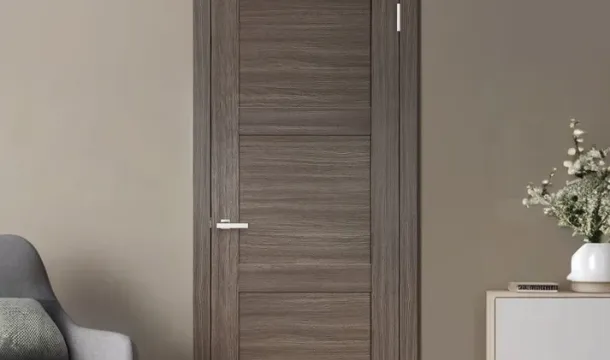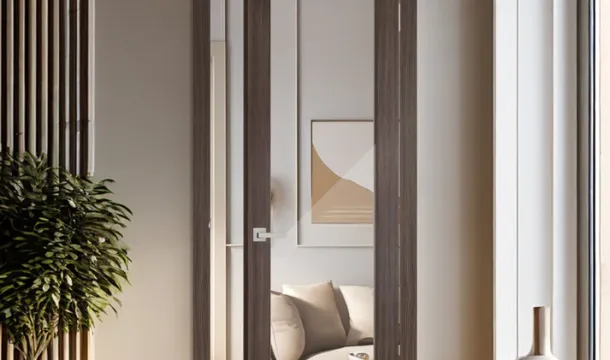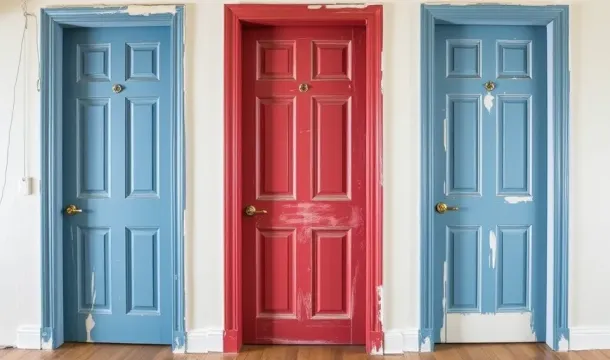Restore vintage interior doors and keep their charm
Popular Articles
Strip paint layers with a heat gun set below 500C, moving constantly to avoid scorching the wood. For intricate details, a chemical stripper applied with a natural bristle brush lifts old varnish from mouldings without damaging the softwood. Once bare, inspect the door for shrinkage; a common issue in Canadian homes is a 3-5mm gap at the top of panels due to our dry winters. Fill these with a tinted beeswax stick, not wood filler, which allows for natural expansion and contraction.
Original hardware often hides under decades of paint. Remove the door and submerge the knobs and plates in a bath of white vinegar and baking soda for 48 hours. This solution dissolves rust and old paint without the abrasion of wire brushes. For a mortise lock that sticks, a graphite-based lubricant is more effective and less messy than WD-40. If the wood feels dry, a mixture of 3 parts raw linseed oil to 1 part turpentine restores flexibility and lustre to the grain, preventing the brittleness that leads to cracks.
Replacing a damaged panel is often more cost-effective than a full door replacement. Measure the panel's thickness precisely; vintage doors typically use 6mm or 9mm panes. A local glass or wood shop can cut a replacement to size. To install, you will need to gently tap out the moulding pins, replace the panel, and re-secure the mouldings with new, headless pins. This method preserves the door's structural integrity and historical value, maintaining its character far better than a modern reproduction.
Assessing Door Condition First
Inspect the door's structural integrity before any cosmetic work. Check for significant warping by placing a straightedge across the surface; gaps exceeding 6mm often require specialized clamping and gluing techniques. Probe the wood along the bottom rail and stiles with a screwdriver. Soft, crumbly wood indicates rot that needs cutting out and dutchman repairs. Loose joints are a primary culprit for wobble. Tighten them using hide glue and clamps, avoiding modern wood glues that can prevent future disassembly.
Examine the hardware and glass. Original, painted-shut mortise locksets are worth saving; a 50/50 mix of vinegar and baking soda can dissolve old paint without damaging the mechanism. For wavy glass panes, look for cracks and check the glazing putty. Brittle, cracked putty must be fully chiseled out and replaced with a period-appropriate linseed oil-based compound to ensure a weather-tight seal and preserve the glass.
Identify the finish type to plan your approach. Shellac and varnish soften with denatured alcohol and lacquer thinner respectively; if the finish liquifies, it's a clear sign for chemical stripping. Paint layers over 100 years old may contain lead. Use an EPA-approved test kit. A positive result mandates wet-sanding or chemical stripping with a NIOSH-approved respirator, never dry sanding. This initial diagnosis dictates whether you need simple refinishing or complex structural repairs, guiding your entire project scope and budget.
Stripping Paint Carefully
Identify the paint type before selecting a stripper. For layers of old oil-based paint, a methylene chloride-based gel stripper works best, as it cuts through thick glazes effectively. With modern latex paints, a citrus-based or soy gel stripper often suffices and is less caustic. Apply a thick, even layer with an inexpensive natural bristle brush, working on one panel or section at a time.
Cover the applied stripper with plastic wrap, like common kitchen cling film. This step prevents the product from drying out, allowing it to work for up to 24 hours and penetrating deeper paint layers. The film traps the solvents, making the chemical reaction more effective and reducing the need for re-application.
Remove the paste and softened paint using a wide metal scraper, keeping the blade flat against the wood. For intricate details on panels, rails, and stiles, use a set of nylon detailing tools and bronze wool. Bronze wool is preferred over steel wool as it scrubs effectively without leaving behind tiny particles that can rust and stain the wood grain.
Neutralize the chemical residue after stripping. For alkaline-based strippers, wipe the surface with a white vinegar solution. For other types, mineral spirits works well. This final wipe-down halts the chemical action and prepares the bare wood for sanding, ensuring no stripper residue interferes with new finishes.
Repairing Wood and Hardware
Fill wood voids and minor damage with a two-part wood epoxy, carving and sanding it to match the original profile once fully cured. For missing wood chunks, glue a new piece of matching timberlike oak or pineusing hide glue or modern PVA wood glue, then shape it with chisels and files. Consolidate rotten but structurally sound areas by injecting a liquid wood hardener; this stabilizes the fibers without replacing the original material.
Restoring Original Hardware
Remove old door knobs, locks, and hinges carefully. Soak them in a bath of white vinegar for 24 hours to dissolve rust, followed by a scrub with a brass brush. For stubborn grime, use a non-abrasive cleaner like Krud Kutter. Polish brass and bronze pieces with 0000-grade steel wool and a paste wax, which protects the metal without creating an overly shiny, new appearance. Lubricate the internal mechanism of mortise locks with graphite powder, not oil, which attracts dust and gums up over time.
Addressing Structural Issues
Repair loose joints by injecting thin cyanoacrylate (CA) glue into the seam, then clamping the joint for one hour. For more significant separation, carefully disassemble the joint, remove old glue, and re-glue with a stronger polyurethane adhesive. Reinforce the joint internally with a hardwood dowel. To fix a warped door, place it across two sawhorses with weight on the crowned center; apply moisture to the concave side with a damp cloth to encourage the wood to expand back into shape over several days.
Popular Articles

Choosing the Perfect Interior Doors for Your Canadian Home

A Complete Guide to Choosing Interior Doors for Canadian Homes
